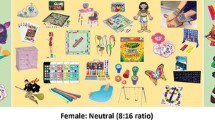Abstract
It has been hypothesised that autism is an extreme version of the male brain, caused by high levels of prenatal testosterone (Baron-Cohen 1999). To test this proposal, associations were assessed between three visuo-spatial tasks and prenatal testosterone, indexed in second-to-fourth digit length ratios (2D:4D). The study included children with Autism Spectrum Disorder, ASD (N = 28), and chronological as well as mental age matched typically-developing children (N = 31). While the group with ASD outperformed the control group at Mental Rotation and Figure-Disembedding, these group differences were not related to differences in prenatal testosterone level. Previous findings of an association between Targeting and 2D:4D were replicated in typically-developing children and children with ASD. The implications of these results for the extreme male brain (EMB) theory of autism are discussed.


Similar content being viewed by others
References
Aleman, A., Bronk, E., Kessels, R. P. C., Koppeschaar, H .P. F., & van Honk, J. (2004). A single administration of testosterone improves visuospatial ability in young women. Psychoneuroendocrinology, 29, 612–617.
Allen, M. J., & Cholet, M. E. (1978). Strength of association between sex and field dependence. Perceptual and Motor Skills, 47, 419–421.
American Psychiatric Association (2000). (DSM-IV-TR) Diagnostic and statistical manual of mental disorders (4th ed.). Washington, DC: American Psychiatric Press, Inc.
Baron-Cohen, S. (1999). The extreme-male-brain theory of autism. In H. Tager-Flusberg (Ed.), Neurodevelopmental disorders (pp.401–430). MIT Press.
Baron-Cohen, S. (2002). The extreme male brain theory of autism. Trends in Cognitive Sciences, 6, 248–254.
Beversdorf, D. Q., Anderson, J. M., Manning, S. E., Anderson, S. L., Nordgren, R. E., Felopulos, G. J., & Bauman, M. L. (2001). Brief report: macrographia in high-functioning adults with autism spectrum disorder. Journal of Autism and Developmental Disorders, 31, 97–101.
Brown, W. M., Hines, M., Fane, B. A., & Breedlove, S. M. (2002). Masculinized finger length patterns in human males and females with congenital adrenal hyperplasia. Hormones and Behavior, 42, 380–386.
De Bruin, E. I., Verheij, F., Wiegman, T., & Ferdinand, R. F. (2006). Differences in finger length ratio between males with autism, pervasive developmental disorder-not otherwise specified, ADHD, and anxiety disorders. Developmental Medicine & Child Neurology, 48, 962–965.
Falter, C. M., Arroyo, M., & Davis, G. J. (2006). Testosterone: Activation or organization of spatial cognition? Biological Psychology, 73, 132–140.
Garn, S. M., Burdi, A. R., Babler, W. J., & Stinson, S. (1975). Early prenatal attainment of adult metacarpal-phalangeal rankings and proportions. American Journal of Physical Anthropology, 43, 327–332.
Gouchie, C., & Kimura, D. (1991). The relationship between testosterone levels and cognitive ability patterns. Psychoneuroendocrinology, 16, 323–334.
Hines, M., Fane, B. A., Pasterski, V. L., Mathews, G. A., Conway, G. S., & Brook, C. (2003). Spatial abilities following prenatal androgen abnormality: targeting and mental rotations performance in individuals with congenital adrenal hyperplasia. Psychoneuroendocrinology, 28, 1010–1026.
Karp, S. A., & Kornstadt, N. L. (1963). Manual for the children’s embedded figures test. Brooklyn, N.Y.: Cognitive Tests.
Kondo, T., Zakany, J., Innis, J. W., Duboule, D. (1997). Of fingers, toes and penises. Nature, 390, 185–198.
Lutchmaya, S., Baron-Cohen, S., Raggatt, P., Knickmeyer, R., & Manning, J. T. (2004). 2nd to 4th digit ratios, fetal testosterone and estradiol. Early Human Development, 77, 23–28.
Manning, J. T., Baron-Cohen, S., Wheelwright, S., & Sanders, G. (2001). The 2nd to 4th digit ratio and autism. Developmental Medicine and Child Neurology, 43, 160–164.
Manning, J. T., Scutt, D., Wilson, J., & Lewis-Jones, D. I. (1998). The ratio of 2nd to 4th digit length: a predictor of sperm numbers and concentrations of testosterone, luteinizing hormone and oestrogen. Human Reproduction, 13, 3000–3004.
Manning, J. T., Stewart, A., Bundred, P. E., & Trivers, R. L. (2004). Sex and ethnic differences in 2nd to 4th digit ratio of children. Early Human Development, 80, 161–168.
Milne, E., White, S., Campbell, R., Swettenham, J., Hansen, P., & Ramus, F. (2006). Motion and form coherence detection in autistic spectrum disorder: Relationship to motor control and 2:4 digit ratio. Journal of Autism and Developmental Disorders, 36, 225–237.
Mottron, L., Peretz, I., & Menard, E. (2000). Local and global processing of music in high-functioning persons with autism: beyond central coherence? Journal of Child Psychology and Psychiatry and Allied Disciplines, 41, 1057–1065.
Plaisted, K., O’Riordan, M., & Baron-Cohen, S. (1998). Enhanced visual search for a conjunctive target in autism: A research note. Journal of Child Psychology and Psychiatry and Allied Disciplines, 39, 777–783.
Raven, J. C. (1995). Coloured progressive matrices. Oxford, UK: Oxford Psychologists Press.
Shah, A., & Frith, U. (1983). An islet of ability in autistic children: a research note. Journal of Child Psychology and Psychiatry and Allied Disciplines, 24, 613–620 .
Shepard, R. N., & Metzler, J. (1971). Mental rotation of three-dimensional objects. Science, 171, 701–703.
Watson, N. V., & Kimura, D. (1991). Nontrivial sex differences in throwing and intercepting: Relation to psychometrically-defined spatial functions. Personality and Individual Differences, 12, 375–385.
Williams, T. J., Pepitone, M. E., Christensen, S. E., Cooke, B. M., Huberman, A. D., Breedlove, N. J., Breedlove, T. J., Jordan, C. L., & Breedlove, S. M. (2000). Finger-length ratios and sexual orientation. Nature, 404, 455–456.
Acknowledgment
The authors would like to thank the children who participated in the study and the schools, teachers and parents who supported our research.
Author information
Authors and Affiliations
Corresponding authors
Rights and permissions
About this article
Cite this article
Falter, C.M., Plaisted, K.C. & Davis, G. Visuo-spatial Processing in Autism—Testing the Predictions of Extreme Male Brain Theory. J Autism Dev Disord 38, 507–515 (2008). https://doi.org/10.1007/s10803-007-0419-8
Received:
Accepted:
Published:
Issue Date:
DOI: https://doi.org/10.1007/s10803-007-0419-8




